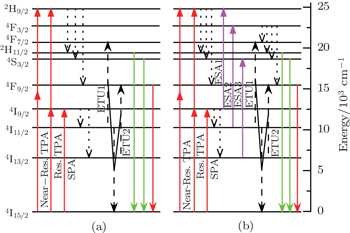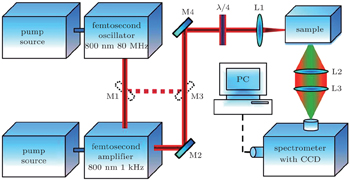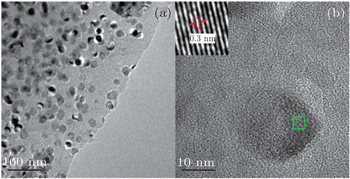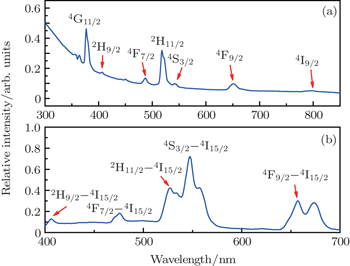† Corresponding author. E-mail:
Project supported by the Young Scientists Fund of the National Natural Science Foundation of China (Grant No. 11304396), the National Natural Science Foundation of China (Grant Nos. 11474096 and 51132004), and the Shanghai Municipal Science and Technology Commission, China (Grant No. 14JC1401500).
We propose a femtosecond laser polarization modulation scheme to control the up-conversion (UC) luminescence in Er3+-doped NaYF4 nanocrystals dispersed in the silicate glass. We show that the UC luminescence can be suppressed when the laser polarization is changed from linear through elliptical to circular, and the higher repetition rate will yield the lower control efficiency. We theoretically analyze the physical control mechanism of the UC luminescence polarization modulation by considering on- and near-resonant two-photon absorption, energy transfer up-conversion, and excited state absorption, and show that the polarization control mainly comes from the contribution of near-resonant two-photon absorption. Furthermore, we propose a method to improve the polarization control efficiency of UC luminescence in rare-earth ions by applying a two-color femtosecond laser field.
Recently, the up-conversion (UC) luminescence of luminescent material doped with rare-earth ions, which converts the low-frequency stimulation into high-frequency emission via two-photon or multi-photon absorption process, has attracted considerable attention because of its unique optical properties, such as narrow emission spectrum, intense luminescence intensity, high conversion efficiency, good optical stability, and long luminescence lifetime, and has been widely used in various related fields, such as light-emitting diodes,[1,2] fiber optic communication,[3,4] laser sources,[5,6] color display,[7,8] medical imaging,[9,10] biological labels,[11,12] etc. If the UC luminescence can be controlled, such as in enhancement, suppression or multi-color tuning, its relevant applications can be greatly extended. By now, several schemes have been proposed to experimentally realize the UC luminescence enhancement, suppression, and tuning. For example, a common method is to adjust the material property by varying its dopant-host combination,[13–15] nanoparticle size,[16,17] and dopant concentration[18,19] in the synthesis process, and the other common method is to control the laser parameter by varying the excitation wavelength,[20] power density,[21] pulse duration,[22] spectral phase[23,24] or polarization.[25,26] In addition, applying an electric or magnetic field has also been proved to be an available method to control the UC luminescence.[27,28]
Because of the surface effect, volume effect, quantum size effect, and macroscopic quantum tunnel effect, the nanocrystal material shows different performances in magnetic, optic, electric, and chemical properties compared with normal bulk material.[29,30] The nanocrystal material doped with rare-earth ions combines the unique optical properties of both nanocrystals and rare-earth ions, and therefore is shown to be a promising alternative to luminescent materials, such as NaGdF4-based nanocrystals for biological fluorescence imaging,[31] NaYbF4:Tm3+/Ho3+/Er3+ and NaYF4:Yb3+ used as biological markers.[32] In the present work, we experimentally and theoretically show that the UC luminescence in Er3+-doped NaYF4 nanocrystals dispersed in the silicate glass can be controlled by varying the femtosecond laser polarization. Our experimental results show that the UC luminescence intensity can be reduced when the laser polarization is changed from linear through elliptical to circular, but the control efficiency will be affected by the laser repetition rate, and the lower repetition rate will yield the higher control efficiency. Our theoretical studies indicate that the polarization modulation depends on the near-resonant two-photon absorption but is independent of the on-resonant two-photon absorption, energy transfer up-conversion, and excited state absorption. In addition, a two-color femtosecond laser field is proposed to improve the polarization control efficiency of UC luminescence by keeping the near-resonant two-photon absorption process but excluding the other excitation processes.
Our experimental arrangement is shown in Fig.
In our experiment, the glass ceramic containing Er3+-doped NaYF4 nanocrystals is used as our study example, which is synthesized via modification from melt-quenching to subsequent heat treatment. The precursor sample is prepared with the molar ratio of 40SiO2-25Al2O3-18Na2CO3-10YF3-7NaF-1ErF3. The original material is mixed and melted in a covered platinum crucible at a temperature of 1450 °C for 45 min in the ambient atmosphere and then cast into a brass mold followed by annealing at a temperature of 450 °C for 10 h. The synthesized glass is heated to a temperature of 600 °C in steps of 10 K/min, kept at this temperature for 2 h, and then cooled to room temperature to form the glass ceramic through crystallization. The glass ceramic sample is cut and polished for optical measurement in our experiment. X-ray diffraction (XRD) analysis is performed to identify the crystallization phase with a power diffractometer (Bruker D8 Advance) operated at 40 kV and 40 mA, and the measured result is shown in Fig.
 | Fig. 2. XRD curve of glass ceramic containing Er3+-doped NaYF4 nanocrystals. Here, those peaks from α-NaYF4 are indexed. |
Transmission electron microscopy (TEM) images of the sample are provided in Fig.
The UV-VIS-NIR absorption spectrum of Er3+-doped NaYF4 nanocrystals is shown in Fig.
Figure
According to the absorption and luminescence spectra of Er3+-doped NaYF4 nanocrystals in Fig.
 | Fig. 6. Energy levels of Er3+ ions and possible pathways of green and red UC luminescences generated by a 1-kHz laser amplifier (a) and an 80-MHz laser oscillator (b). |
As can be seen in Fig.
As discussed above, the polarization modulations of green and red UC luminescence come from the contribution of the near-resonant TPA process. In order to demonstrate the effect of the femtosecond laser polarization on the near-resonant TPA process, we theoretically simulate the resonance-mediated TPA in the Er3+ ions by a time-dependent perturbation theory.[33] Usually, the multi-photon absorption in a quantum system with a broad absorption line can be simplified into the sum of all individual transitions. Based on the theoretical model of the atom system with narrow absorption line limit,[34,35] the resonance-mediated two-photon transition probability S(1+1) in the Er3+ ions can be approximated as















When a linearly polarized laser field is modulated by the quarter wave plate, its polarization status will be changed. Mathematically, the polarization-modulated laser field can be defined by the function of








Since the polarization modulations of green and red UC luminescence result from the near-resonant TPA process, it is necessary to increase the weight of the near-resonant TPA component in the whole excitation process in order to improve the polarization control efficiency. One simple way is to keep the near-resonant TPA process and exclude other excitation processes. In this experiment, the on-resonant TPA, ESA and ETU processes are correlated with the absorption in the intermediate state 4I9/2, and thus a two-color laser field may be a well-established tool to eliminate these excitation processes but keep the near-resonant TPA process. In the two-color excitation process, both laser fields should be far from the resonant absorption of intermediate state 4I9/2, but the sum of their frequencies should be equal to the transition frequency of excited state 2H9/2. By such a two-color laser field excitation, the green and red UC luminescence may be suppressed, but their polarization control efficiencies should be improved, and the polarization modulation should not be affected by the laser repetition rate.
In this study, we experimentally and theoretically demonstrate that the femtosecond laser polarization can control the UC luminescence in Er3+-doped NaYF4 nanocrystals dispersed in the silicate glass. It is shown that the circular polarization will suppress the UC luminescence, but the polarization control is affected by the laser repetition rate, and a higher repetition rate leads to a lower control efficiency. It is also shown that the UC luminescences come from the TPA, ETU, and ESA processes, but the polarization modulation only results from the near-resonant TPA process. Furthermore, the two-color femtosecond laser field is shown to be a feasible method to keep the near-resonant TPA process and exclude other excitation processes, and consequently can improve the polarization control efficiency. The study presents a clear physical process for the polarization control of UC luminescence in Er3+-doped NaYF4 nanocrystals, which is very useful for further understanding and controlling the UC luminescences in various luminescent materials. The laser polarization modulation provides a very simple method to control various nonlinear optical processes, and therefore these theoretical and experimental results can be used as the study basis in related fields.
| 1 | |
| 2 | |
| 3 | |
| 4 | |
| 5 | |
| 6 | |
| 7 | |
| 8 | |
| 9 | |
| 10 | |
| 11 | |
| 12 | |
| 13 | |
| 14 | |
| 15 | |
| 16 | |
| 17 | |
| 18 | |
| 19 | |
| 20 | |
| 21 | |
| 22 | |
| 23 | |
| 24 | |
| 25 | |
| 26 | |
| 27 | |
| 28 | |
| 29 | |
| 30 | |
| 31 | |
| 32 | |
| 33 | |
| 34 | |
| 35 | |
| 36 |






